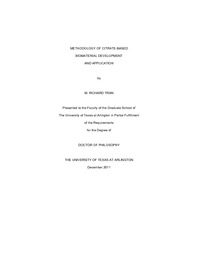| dc.description.abstract | Biomaterials play central roles in modern strategies of regenerative medicine and tissue engineering. Attempts to find tissue-engineered solutions to cure various injuries or diseases have led to an enormous increase in the number of polymeric biomaterials over the past decade. The breadth of new materials arises from the multiplicity of anatomical locations, cell types, and mode of application, which all place application-specific requirements on the biomaterial. Unfortunately, many of the currently available biodegradable polymers are limited in their versatility to meet the wide range of requirements for tissue engineering. Therefore, a methodology of biomaterial development, which is able to address a broad spectrum of requirements, would be beneficial to the biomaterial field. This work presents a methodology of citrate-based biomaterial design and application to meet the multifaceted needs of tissue engineering. We hypothesize that 1) citric acid, a non-toxic metabolic product of the body (Krebs Cycle), can be exploited as a universal multifunctional monomer and reacted with various diols to produce a new class of soft biodegradable elastomers with the flexibility to tune the material properties of the resulting material to meet a wide range of requirements; 2) the newly developed citrate-based polymers can be used as platform biomaterials for the design of novel tissue engineering scaffolding; and 3) microengineering approaches in the form thin scaffold sheets, microchannels, and a new porogen design can be used to generate complex cell-cell and cell-microenvironment interactions to mimic tissue complexity and architecture. To test these hypotheses, we first developed a methodology of citrate-based biomaterial development through the synthesis and characterization of a family of in situ crosslinkable and urethane-doped elastomers, which are synthesized using simple, cost-effective strategies and offer a variety methods to tailor the material properties to meet the needs of a particular application. Next, we introduced a new porogen generation technique, and showed the potential application of the newly developed materials through the fabrication and characterization of scaffold sheets, multiphasic small diameter vascular grafts, and multichanneled nerve guides. Finally, the in vivo applications of citrate-based materials are exemplified through the evaluation of peripheral nerve regeneration using multichanneled guides and the ability to assist in injection-based endoscopic mucosal resection therapy. The results presented in this work show that citric acid can be utilized as a cornerstone in the development of novel biodegradable materials, and combined with microengineering approaches to produce the next generation of tissue engineering scaffolding. These enabling new biomaterials and scaffolding strategies should address many of the existing challenges in tissue engineering and advance the field as a whole. | en_US |

